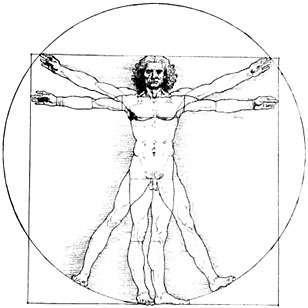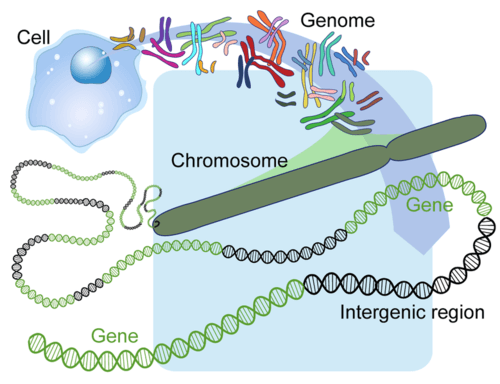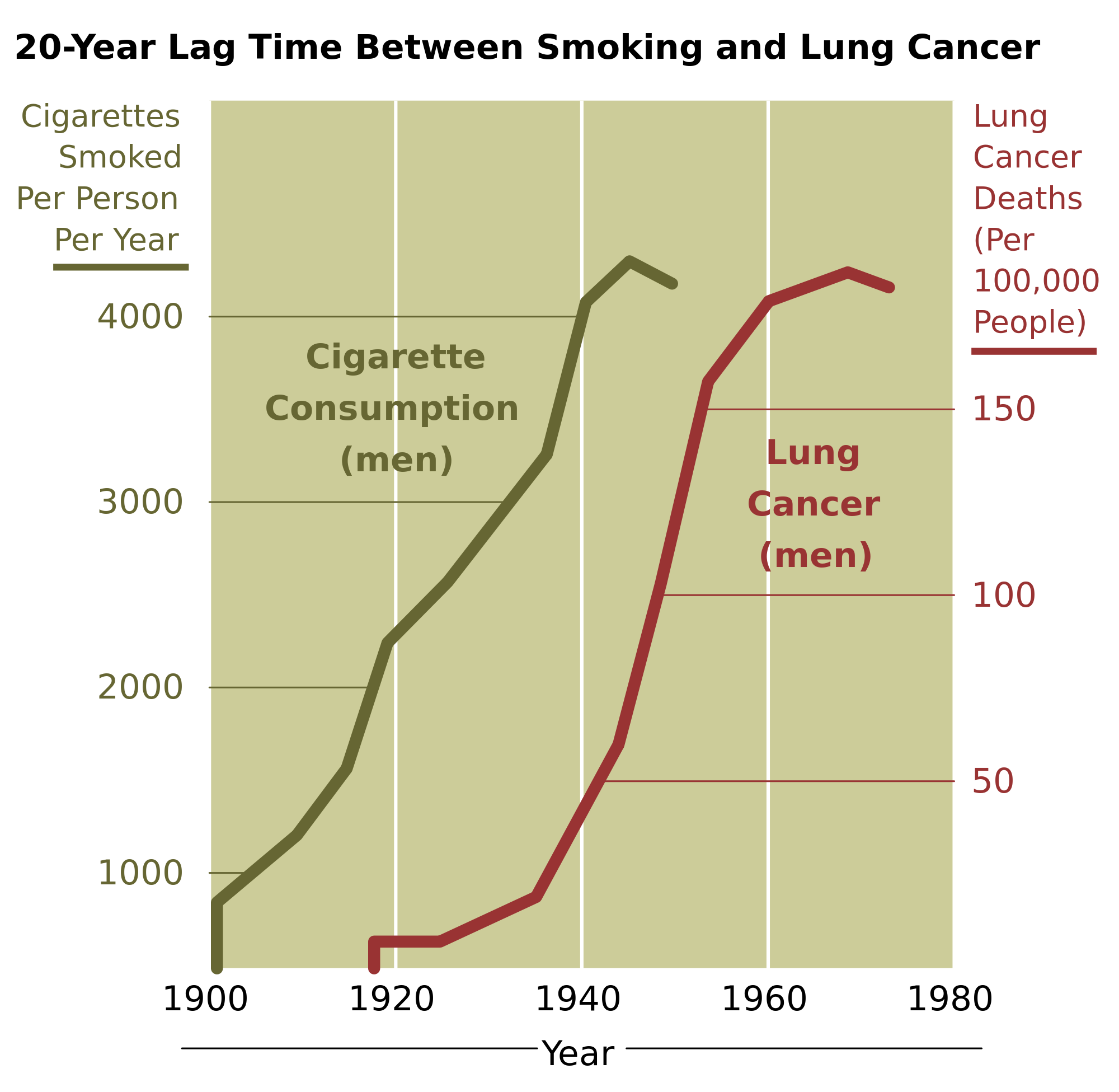5.17 The Human Genome

Vitruvian Man
The drawing in Figure 5.17.1, named Vitruvian Man, was created by Leonardo da Vinci in 1490. It was meant to show normal human body proportions. Vitruvian Man is used today to represent a different approach to the human body. It symbolizes a scientific research project that began in 1990, exactly 500 years after da Vinci created the drawing. That project, called the Human Genome Project, is the largest collaborative biological research project ever undertaken.
What Is the Human Genome?
The human genome refers to all the DNA of the human species. Human DNA consists of 3.3 billion base pairs, and it is divided into more than 20 thousand genes on 23 chromosomes. Humans inherit one set of chromosomes from each parent. So there are actually two copies of each of those 20,000 genes. The human genome also includes noncoding sequences of DNA, as shown in Figure 5.17.2.

Discovering the Human Genome
Scientists now know the sequence of all the DNA base pairs in the entire human genome. This knowledge was attained by the Human Genome Project (HGP), a $3 billion, international scientific research project that was formally launched in 1990. The project was completed in 2003, two years ahead of its 15-year projected deadline.
Determining the sequence of the billions of base pairs that make up human DNA was the main goal of the HGP. Another goal was to map the location and determine the function of all the genes in the human genome. A somewhat surprising finding of the HGP is the relatively small number of human genes. There are only about 20,500 genes in human beings. This may sound like a lot, but it’s about the same number as in mice. Another surprising finding of the HGP is the large number of nearly identical, repeated DNA segments in the human genome. This number was previously believed to be much smaller.
A Collaborative Effort

Funding for the HGP came from the U.S. Department of Energy and the National Institutes of Health, as well as from foreign institutions. The actual research was undertaken by scientists in 20 universities in the U.S., United Kingdom, Australia, France, Germany, Japan, and China. A private U.S. company named Celera also contributed to the effort. Although Celera had hoped to patent some of the genes it discovered, this was later denied. The entire DNA sequence of the genome is stored in databases that are available to anyone on the Internet. Additional data and tools for analyzing the human genome are also available online.
Reference Genome of the Human Genome Project
In 2003, the HGP published the results of its sequencing of DNA as a human reference genome. The reference genome sequences a full set of human chromosomes, but it clearly doesn’t represent the sequence of every human individual’s genome. Instead, it is the combined mosaic of a small number of anonymous donors. The DNA that was sequenced came from blood samples of the female donors and sperm samples of the male donors. All of the donors were of European origin, and more than 70 per cent of the reference DNA came from a single anonymous male donor from Buffalo, New York. Identities of all the donors were protected so neither they nor the researchers could know whose DNA was sequenced.
Subsequent projects have sequenced the genomes of multiple distinct ethnic groups. Ongoing research is searching base by base for variations in the sequence. However, there is still only one reference genome available.
Benefits of the Human Genome Project
The sequencing of the human genome has benefits for many fields, including molecular medicine and human evolution.
- Knowing the human DNA sequence can help us understand many human diseases. For example, it is helping researchers identify mutations linked to different forms of cancer. It is also yielding insights into the genetic basis of cystic fibrosis, liver diseases, blood-clotting disorders, and Alzheimer’s disease, among others.
- The human DNA sequence can also help researchers tailor medications to individual genotypes. This is called personalized medicine, and it has led to an entirely new field called pharmacogenomics. Pharmacogenomics, also called pharmacogenetics, is the study of how our genes affect the way we respond to drugs. You can read more about pharmacogenomics in the Feature section below.
- The analysis of similarities between DNA sequences from different organisms is opening new avenues in the study of evolution. For example, analyses are expected to shed light on many questions about the similarities and differences between humans and our closest relatives, the nonhuman primates.
Ethical, Legal, and Social Issues of the Human Genome Project
From its launch in 1990, the HGP proactively established and funded a separate committee to oversee potential ethical, legal, and social issues associated with the project. Some of these possible issues include:
- The possible use of the knowledge generated by the project to discriminate against people. There were worries that that employers and health insurance companies would refuse to hire or insure people based on their genetic makeup, for instance, if they had genes that increased their risk of getting certain diseases.
- The issues surrounding “ownership” of DNA sequences. There have been requests by the both governmental agencies and private companies for patents of certain sequences of human genes called cDNA, although the US Patent Office has rejected all applications.
- Education of healthcare professionals, policy makers and the public about the complex issues involved in the HGP and what is done with the information acquired from it.
Feature: Human Biology in the News
Not everyone responds to medications in the same way. A drug that works well for one person may not be effective for another. The dose of a drug that cures a disease in one individual may be inadequate for someone else. Some people may experience side effects from a given medication, whereas other people do not. This variation in responses to medications can be due to differences in our genes. That’s where the field of pharmacogenetics comes in. News media have hailed it as the “new frontier in medicine.” It certainly seems to hold promise for improving the treatment of patients with pharmaceutical drugs.
Pharmacogenomics is based on a special kind of genetic testing. It looks for small genetic variations that influence a person’s ability to activate and deactivate drugs. Results of the tests can help doctors choose the best drug and most effective dose for a given patient. Some of the greatest successes of pharmacogenomics have been in cancer treatment. Many of the drugs that treat cancer need to be activated by the patient’s own enzymes. Inherited variations in enzymes may affect how quickly or efficiently the drugs are activated. For example, if a patient’s enzymes break down a particular drug too slowly, then standard doses of the drug may not work very well for that patient. Drugs also must be deactivated to reduce their effects on healthy cells. If a patient’s enzymes deactivate a drug too slowly, then the drug may remain at high levels and cause side effects.
One of the main benefits of pharmacogenomics is greater patient safety. Pharmacogenomic testing may help identify patients who are likely to experience adverse reactions to drugs, so that different, safer drugs can be prescribed. Another benefit of pharmacogenomics is eliminating the trial-and-error approach that is often used to find appropriate medications and doses for a given patient. This saves time and money, as well as improving patient outcomes.
Because pharmacogenomics is new, some insurance companies do not cover it, and it can be very expensive. Also, not all of the genetic tests are widely available at this point. In addition, there may be ethical and legal issues associated with the genetic testing, including concerns about privacy issues.
5.17 Summary
- The human genome refers to all of the DNA of the human species. It consists of more than 3.3 billion base pairs divided into 20,500 genes on 23 pairs of chromosomes.
- The Human Genome Project (HGP) was a multi-billion dollar international research project that began in 1990. By 2003, it had sequenced all of the DNA base pairs in the human genome. It also mapped the location and determined the function of all the genes in the human genome.
- In 2003, the HGP published the results of its sequence of DNA as a human reference genome. The entire DNA sequence is stored in databases that are available to anyone on the Internet.
- Sequencing of the human genome is helping researchers better understand cancer and genetic diseases. It is also helping them tailor medications to individual patients, which is the focus of the new field of pharmacogenomics. In addition, it is helping researchers better understand human evolution.
- From its launch in 1990, the HGP established and funded a separate committee to oversee potential ethical, legal, and social issues associated with the project.
5.17 Review Questions
- Describe the human genome.
- What is the Human Genome Project?
- Identify two main goals of the Human Genome Project.
- What is the reference genome of the Human Genome Project? What is it based on?
- Explain how knowing the sequence of DNA bases in the human genome is beneficial for molecular medicine.
- What was one surprising finding of the Human Genome Project?
- Why do you think scientists didn’t just sequence the DNA from a single person for the Human Genome Project? Along those lines, why do you think it is important to include samples from different ethnic groups and genders in genome sequencing efforts?
- What is pharmacogenomics?
- If a patient were to have pharmacogenomics done to optimize their medication, what do you think the first step would be?
- List one advantage and one disadvantage of pharmacogenomics.
- Explain how the sequencing of the human genome relates to ethical concerns about genetic discrimination.
5.17 Explore More
The race to sequence the human genome – Tien Nguyen, TED-Ed, 2015.
How to read the genome and build a human being | Riccardo Sabatini, TED, 2016.
Personalized Medicine: A New Approach | Luigi Boccuto | TEDxGreenville,
TEDx Talks, 2017.
Attributions
Figure 5.17.1
Vitruvian_man (black and white copy) by Leonardo Da Vinci, 1490, by Ianbond on Wikimedia Commons is released into the public domain (https://en.wikipedia.org/wiki/Public_domain).
Figure 5.17.2
Human Genome by CK-12 Foundation is used under a CC BY-NC 3.0 (https://creativecommons.org/licenses/by-nc/3.0/) license.
 ©CK-12 Foundation Licensed under
©CK-12 Foundation Licensed under ![]() • Terms of Use • Attribution
• Terms of Use • Attribution
Figure 5.17.3
Human genome_bookcase by Russ London at English Wikipedia is used under a CC BY-SA 3.0 (https://creativecommons.org/licenses/by-sa/3.0/deed.en) license.
References
Brainard, J/ CK-12 Foundation. (2016). Figure 2 Human genome, chromosomes, and genes. [digital image]. In CK-12 College Human Biology (Section 5.16) [online Flexbook]. CK12.org. https://www.ck12.org/book/ck-12-college-human-biology/section/5.16/
National Human Genome Research Institute (NHGRI). (n.d.). The Human Genome Project (HGP). National Institute of Health (NIH) /US Government. https://www.genome.gov/human-genome-project
TED. (2016, May 24). How to read the genome and build a human being | Riccardo Sabatini. YouTube. https://www.youtube.com/watch?v=s6rJLXq1Re0&t=2s
TED-Ed. (2015, October 12). The race to sequence the human genome – Tien Nguyen. YouTube. https://www.youtube.com/watch?v=AhsIF-cmoQQ&t=7s
TEDx Talks. (2017, June 8). Personalized medicine: A new approach | Luigi Boccuto | TEDxGreenville. https://www.youtube.com/watch?v=J2ITkfzp0SY&t=4s
Wikipedia contributors. (2020, April 18). Celera Corporation. In Wikipedia. https://en.wikipedia.org/w/index.php?title=Celera_Corporation&oldid=951693886
Wikipedia contributors. (2020, July 6). Human Genome Project. In Wikipedia. https://en.wikipedia.org/w/index.php?title=Human_Genome_Project&oldid=966272762
Wikipedia contributors. (2020, July 12). Leonardo da Vinci. In Wikipedia. https://en.wikipedia.org/w/index.php?title=Leonardo_da_Vinci&oldid=967303882
Wikipedia contributors. (2020, May 19). Vitruvian Man. In Wikipedia. https://en.wikipedia.org/w/index.php?title=Vitruvian_Man&oldid=957472578
A coiled, fluid-filled tube in the inner ear that changes mechanical sound vibrations and positional information to nerve impulses that travel to the brain.
A sequence of nucleotides in DNA or RNA that codes for a molecule that has a function.
A threadlike structure of nucleic acids and protein found in the nucleus of most living cells, carrying genetic information in the form of genes.
Component of a homeostatic control mechanism that monitors a variable and sends signals to the effector as needed to keep the variable in homeostasis.
A group of diseases involving abnormal cell growth with the potential to invade or spread to other parts of the body.
The part of the genetic makeup of a cell, and therefore of any individual, which determines one of its characteristics (phenotype).
The study of how our genes affect the way we respond to drugs.
Created by CK-12 Foundation/Adapted by Christine Miller

Sure Death
This anti-smoking photo (Figure 13.6.1) clearly makes the point that smoking causes death. The image is not using hyperbole, because smoking actually is deadly. It causes about 7 million deaths each year, and is the single greatest cause of preventable death worldwide. As many as half of all people who smoke tobacco die from it. As a result of smoking’s deadly effects, the life expectancy of long-term smokers is significantly less than that of non-smokers. In fact, long-term smokers can expect their lifespan to be reduced by as much as 18 years, and they are three times more likely than non-smokers to die before the age of 70.
Why Is Smoking Deadly?
As shown in Figure 13.6.2, tobacco smoking has adverse effects on just about every bodily system and organ. The detrimental health effects of smoking depend on the number of years that a person smokes and how much the person smokes. Contrary to popular belief, all forms of tobacco smoke — including smoke from cigars and tobacco pipes — have similar health risks as those of cigarette smoke. Smokeless tobacco may be less of a danger to the lungs and heart, but it, too, has serious health effects. It significantly increases the risk of cancers of the mouth and throat, among other health problems.

Even non-smokers may not be spared the deadly risks of tobacco smoke. If you spend time around smokers either at home or on the job, then you are at risk of the dangers of secondhand smoke. Secondhand smoke enters the air directly from burning cigarettes (and cigars and pipes), and indirectly from smokers' lungs. This smoke may linger in indoor air for hours, and it increases the risk of a wide range of adverse health effects. According to Health Canada, second-hand smoke causes 800 deaths from lung cancer and heart disease in non-smokers every year. The 2014 U.S. Surgeon General’s Report concluded that there is no established risk-free level of exposure to secondhand smoke. Non-smokers who are exposed to secondhand smoke may have as much as a 30 per cent increase in their risk of lung cancer and heart disease.
Tobacco contains nicotine, which is a psychoactive drug. Although nicotine in tobacco smoke does not directly cause cancer or most of the other health risks of smoking, it is a highly addictive drug. Nicotine is actually even more addictive than cocaine or heroin. The addictive nature of nicotine explains why it is so difficult for smokers to quit the habit, even when they know the health risks and really want to stop smoking. The good news is that if someone does stop smoking, his or her risks of smoking-related diseases and death soon start to fall. By one year after quitting, the risk of heart disease drops to only half of that of a continuing smoker.
Smoking and Cancer
One of the main health risks of smoking is cancer, particular cancer of the lung. Because of the increased risk of lung cancer with smoking, the risk of dying from lung cancer before age 85 is more than 20 times higher for a male smoker than for a male non-smoker. As the rate of smoking increases, so does the rate of lung cancer deaths, although the effects of smoking on lung cancer deaths can take up to 20 years to manifest themselves, as shown in Figure 13.6.3. Besides lung cancer, several other forms of cancer are also significantly more likely in smokers than non-smokers, including cancers of the kidney, larynx, mouth, lip, tongue, throat, bladder, esophagus, pancreas, and stomach. Unfortunately, many of these cancers have extremely low cure rates.

When you consider the composition of tobacco smoke, it’s not surprising that it increases the risk of cancer. Tobacco smoke contains dozens of chemicals proven to be carcinogens, or causes of cancer. Many of these chemicals bind to DNA in a smoker’s cells, and may either kill the cells or cause mutations. If the mutations inhibit programmed cell death, the cells can survive to become cancer cells. Some of the most potent carcinogens in tobacco smoke include benzopyrene, acrolein, and nitrosamines. Other carcinogens in tobacco smoke are radioactive isotopes, including lead-210 and polonium-210.
Respiratory Effects of Smoking
Long-term exposure to the compounds found in cigarette smoke — such as carbon monoxide and cyanide — are thought to be responsible for much of the lung damage caused by smoking. These chemicals reduce the elasticity of alveoli, leading to chronic obstructive pulmonary disease (COPD). COPD is a permanent, incurable, and often fatal reduction in the capacity of the lungs, reducing the lungs' ability to fully exhale air. The chronic inflammation that is also present in COPD is exacerbated by the tobacco smoke carcinogen acrolein and its derivatives. COPD is almost completely preventable simply by not smoking and by also avoiding secondhand smoke.
Cardiovascular Effects of Smoking
Inhalation of tobacco smoke causes several immediate responses in the heart and blood vessels. Within one minute of inhalation of smoke, the heart rate begins to rise, increasing by as much as 30 per cent during the first ten minutes of smoking. Carbon monoxide in tobacco smoke binds with hemoglobin in red blood cells, thereby reducing the blood’s ability to carry oxygen. Hemoglobin bound to carbon monoxide forms such a stable complex that it may result in a permanent loss of red blood cell function. Several other chemicals in tobacco smoke lead to narrowing and weakening of blood vessels, as well as an increase in substances that contribute to blood clotting. These changes increase blood pressure and the chances of a blood clot forming and blocking a vessel, thereby elevating the risk of heart attack and stroke. A recent study found that smokers are five times more likely than non-smokers to have a heart attack before the age of 40.
Smoking has also been shown to have a negative impact on levels of blood lipids. Total cholesterol levels tend to be higher in smokers than non-smokers. Ratios of “good” cholesterol to “bad” cholesterol tend to be lower in smokers than non-smokers.
Additional Adverse Health Effects of Smoking
A wide diversity of additional adverse health effects are attributable to smoking. Here are just a few of them:
- Smokers are at significantly increased risk of developing chronic kidney disease (in addition to kidney cancer). For example, smoking hastens the progression of kidney damage in people with diabetes.
- People who smoke — especially the elderly — have a greater risk of influenza and other infectious diseases than non-smokers. Smoking more than 20 cigarettes a day has been found to increase the risk of infectious diseases by as much as four times the risk in non-smokers. These effects occur because of damage to both the respiratory system and the immune system.
- In addition to oral cancer, smoking causes other oral problems, including periodontitis (gum disease). Roughly half of the cases of gum inflammation are attributable to current or former smoking. This inflammation increases the risk of tooth loss, which is also higher in smokers than non-smokers. In addition, smoking stains the teeth and causes halitosis (bad breath).
- Smoking is a key cause of erectile dysfunction (ED), probably because it leads to narrowing of arteries in the penis, as it does elsewhere in the body. The incidence of ED is about 85 per cent higher in males who smoke than it is in non-smokers.
- Smoking also has adverse effects on the female reproductive system, potentially causing infertility, in part because it interferes with the body’s ability to produce estrogen. Female smokers are about 60 per cent more likely to be infertile than non-smokers. Pregnant women who smoke or are exposed to secondhand smoke have a higher risk of miscarriages and low-birth-weight infants.
- Certain therapeutic drugs, including some antidepressants and anticonvulsants, are less effective in smokers than in non-smokers. This occurs because smoking increases levels of liver enzymes that break down the drugs.
- Smoking causes an estimated ten per cent of all fire-related deaths worldwide. Smokers are also at a greater risk of dying in motor vehicle crashes and other accidents.
- Smoking leads to an increased risk of bone fractures, especially of the hip. It also leads to slower wound healing after surgery, and an increased rate of postoperative complications.
Feature: Human Biology in the News

The item in Figure 13.6.4 looks like a regular cigarette, but it’s actually an electronic cigarette, or e-cigarette. E-cigarettes are battery-powered devices that change flavored liquids and nicotine into vapor that the user inhales. E-cigarettes are often promoted as being safer than traditional tobacco products, and their use is touted as a good way to quit smoking. They are often not banned in smoke-free areas, where it is illegal to smoke tobacco cigarettes.
A study completed in 2015 by researchers at the Harvard School of Public Health and widely reported in the mass media found that e-cigarettes may, in fact, be very harmful to the user’s health. E-cigarettes contain nicotine and cancer-causing chemicals, such as formaldehyde. According to the study, about three-quarters of flavored e-cigarettes also contain a chemical called diacetyl that causes an incurable and potentially fatal disorder of the lungs, commonly called “popcorn lung” (bronchiolitis obliterans). In this disorder, the bronchioles compress and narrow due to the formation of scar tissue, greatly diminishing the breathing capacity of people with the disorder. Popcorn lung gained its common name in 2004, when it was diagnosed in workers at popcorn factories. The buttery flavoring used in the factories contained diacetyl.
Some manufacturers of e-cigarettes and flavorings advertise that their products are now free of diacetyl. However, because e-cigarettes are not currently regulated by the FDA, there is no way of knowing for sure whether the products are actually safe. Equally disturbing is the appeal of flavored e-cigarettes to teens and producers' attempts to specifically market their products to this age group. Flavors such as “cotton candy,” “Katy Perry’s cherry,” and “alien blood” are obviously marketed to youth. Not surprisingly, the use of e-cigarettes is on the rise in middle and high school students, who are more likely to use them than regular cigarettes. Public health officials fear that e-cigarettes will be a gateway for teens to move on to smoking tobacco cigarettes. Some U.S. states have recently passed laws prohibiting minors from buying e-cigarettes, and Brazil, Singapore, Uruguay, and India have banned e-cigarettes. E-cigarettes were not initially regulated by Health Canada because they don't contain nicotine, which made them illegal to sell, but this was not widely enforced. However, Canada enacted the Tobacco and Vaping Products Act (TVPA) on May 23, 2018. As more questions are raised about their potential negative health effects, it is likely that more laws will be passed to regulate e-cigarettes. Watch the news for updates on this issue.
13.6 Summary
- Smoking is the single greatest cause of preventable death worldwide. It has adverse effects on just about every body system and organ. Tobacco smoke affects not only smokers, but also non-smokers who are exposed to secondhand smoke. The nicotine in tobacco is highly addictive, making it very difficult to quit smoking.
- A major health risk of smoking is cancer of the lungs. Smoking also increases the risk of many other types of cancer. Tobacco smoke contains dozens of chemicals known as carcinogens.
- Smoking is the primary cause of chronic obstructive pulmonary disease (COPD). Chemicals such as carbon monoxide and cyanide in tobacco smoke reduce the elasticity of alveoli so the lungs can no longer fully exhale air.
- Smoking damages the cardiovascular system and increases the risk of high blood pressure, blood clots, heart attack, and stroke. Smoking also has a negative impact on levels of blood lipids.
- A wide diversity of additional adverse health effects are attributable to smoking, such as erectile dysfunction, female infertility, and slow wound healing.
13.6 Review Questions
- Create a pamphlet aimed at informing teenagers about the dangers of smoking. Include information about numbers of deaths associated with smoking, life expectancy of smokers, and long term healthy effects of smoking and exposure to second-hand smoke. Include a section on the chemicals present in tobacco smoke and e-cigarettes and some of the adverse affects associated with these chemicals.
- What smoking-related factors determine how smoking affects a smoker’s health?
- What are the two sources of secondhand cigarette smoke? How does exposure to secondhand smoke affect non-smokers?
- Why is it so difficult for smokers to quit the habit? How is their health likely to be affected by quitting?
- Why does smoking cause cancer? List five types of cancer that are significantly more likely in smokers than non-smokers.
- Explain how smoking causes COPD.
- Do you think e-cigarettes can be addictive? Explain your reasoning.
13.6 Explore More
https://www.youtube.com/watch?v=lgVvnnnawvw&feature=emb_logo
Blowing Smoke: The Lost Legacy of the Surgeon General's Report | Alan Blum | TEDxTuscaloosa, TEDx Talks, 2015.
https://www.youtube.com/watch?v=QL2-EsjfiAU
The dangers of vaping, RWJ Barnabas Health, 2019.
Attributions
Figure 13.6.1
Cigarette by Uitbundig on Unsplash is used under the Unsplash License (https://unsplash.com/license)
Figure 13.6.2
Risks_from_smoking-smoking_can_damage_every_part_of_the_body by CDC on Wikimedia Commons is in the public domain (https://en.wikipedia.org/wiki/Public_domain).
Figure 13.6.3
Cancer_smoking_lung_cancer_correlation_from_NIH.svg by Sakurambo on Wikimedia Commons is in the public domain (https://en.wikipedia.org/wiki/Public_domain).
Figure 13.6.4
An_Electronic_Cigarette_(11359245033) by Lindsay Fox from Newport beach, United States on Wikimedia Commons is used under a CC BY 2.0 (https://creativecommons.org/licenses/by/2.0) license.
References
Allen, J. G., Flanigan, S. S., LeBlanc, M., Vallarino, J., MacNaughton, P., Stewart, J. H., Christiani, D.C. (2016, June 1). Flavoring chemicals in E-Cigarettes: Diacetyl, 2,3-Pentanedione, and Acetoin in a sample of 51 products, including fruit-, candy-, and cocktail-flavored E-cigarettes [online article]. Environmental Health Perspectives, 124:733–739. https://doi.org/10.1289/ehp.1510185
Health Canada. (2015). Dangers of second-hand smoke [online article]. Government of Canada. https://www.canada.ca/en/health-canada/services/smoking-tobacco/avoid-second-hand-smoke/second-hand-smoke/dangers-second-hand-smoke.html
RWJ Barnabas Health. (2019, September 25). The dangers of vaping. YouTube. https://www.youtube.com/watch?v=QL2-EsjfiAU&feature=youtu.be
TEDx Talks. (2015, August 7). Blowing smoke: The lost legacy of the surgeon general's report | Alan Blum | TEDxTuscaloosa. https://www.youtube.com/watch?v=lgVvnnnawvw&feature=youtu.be
Tobacco and Vaping Products Act. (2016, June 26). Government of Canada. https://www.canada.ca/en/health-canada/services/health-concerns/tobacco/legislation/federal-laws/tobacco-act.html
Vaping, E-cigarettes to be regulated by Health Canada. (2016, November 22). CBC/Radio-Canada. HTTP://www.cbc.ca/news/health/vaping-health-canada-legislation-1.3862589
Wikipedia contributors. (2020, August 9). Regulation of electronic cigarettes. In Wikipedia. https://en.wikipedia.org/w/index.php?title=Regulation_of_electronic_cigarettes&oldid=972059825

